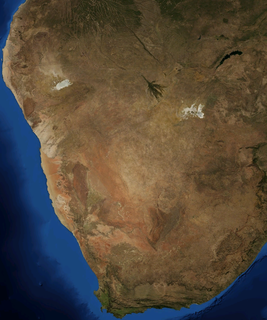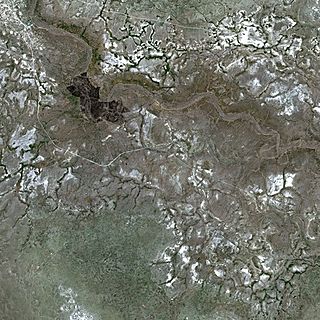Related Research Articles

Botswana is a landlocked country located in Southern Africa, north of South Africa. Botswana occupies an area of 581,730 square kilometres (224,610 sq mi), of which 566,730 km2 (218,820 sq mi) are land. Botswana has land boundaries of combined length 4,347.15 kilometres (2,701.19 mi), of which the constituent boundaries are shared with Namibia, for 1,544 km (959 mi); South Africa 1,969 km (1,223 mi); Zimbabwe, 834 km (518 mi) and Zambia, 0.15 km (0.093 mi). Much of the population of Botswana is concentrated in the eastern part of the country.

The Kalahari Desert is a large semi-arid sandy savannah in Southern Africa extending for 900,000 square kilometres (350,000 sq mi), covering much of Botswana, and parts of Namibia and South Africa.

Lake Makgadikgadi was a paleolake that existed in what is now the Kalahari Desert in Botswana from 2,000,000 years BP to 10,000 years BP. It may have once covered an area of from 80,000 to 275,000 km2 and was 30 m deep. The Okavango, Upper Zambezi, and Cuando rivers once all emptied into the lake. Its remains are seen in the Makgadikgadi salt pans, one of the largest salt pans in the world.
Gloeocapsa is a genus of cyanobacteria. The cells secrete individual gelatinous sheaths which can often be seen as sheaths around recently divided cells within outer sheaths. Recently divided cell pairs often appear to be only one cell since the new cells cohere temporarily. They are also known as glow caps, a term derived from the yellowish hue given off by the cap.

The Makgadikgadi Pan, a salt pan situated in the middle of the dry savanna of north-eastern Botswana, is one of the largest salt flats in the world. The pan is all that remains of the formerly enormous Lake Makgadikgadi, which once covered an area larger than Switzerland, but dried up tens of thousands of years ago. Recent studies of human mitochondrial DNA suggest that modern Homo sapiens first began to evolve in this region some 200,000 years ago, when it was a vast, exceptionally fertile area of lakes, rivers, marshes, woodlands and grasslands especially favorable for habitation by evolving hominins and other mammals.

The Kalahari Basin, also known as the Kalahari Depression or the Okavango Basin, is an endorheic basin and large lowland area covering over 2.5 million km2 covering most of Botswana and Namibia, as well as parts of Angola, South Africa, Zambia, and Zimbabwe. The outstanding physical feature in the basin, and occupying the centre, is the large Kalahari Desert.

Branchinella is a genus of crustaceans in the family Thamnocephalidae. This fairy shrimp genus is found across many parts of the world, but especially western Australia and southern Africa.

Mopipi is a village in Central District of Botswana. It is located close to Makgadikgadi Pan. The population was 3,066 in 2001 census. This area has witnessed steady aridification and desertfication since the Pleistocene, but perhaps most dramatically since the 19th century. In particular, the Boteti River used to flow year around in this area on its way to discharge to the Makgadikgadi Pans, but presently this flow is only in the rainy season.

Nitzschia is a common pennate marine diatom. In the scientific literature, this genus, named after Christian Ludwig Nitzsch, is sometimes termed Nitzchia, and it has many species described, which all have a similar morphology.
Branchinella spinosa is a species within the family Thamnocephalidae. This fairy shrimp species occurs in parts of Southern Africa, notably the Makgadikgadi Pans of Botswana. Other crustacean species found in this region of Botswana in co-existence with B. spinosa include Moina belli.

The Ntwetwe Pan is a large salt pan within the Makgadikgadi region of Botswana. The Ntwetwe is one of three large pans within the Makgadikgadi, the other two being Nxai Pan and Sua Pan. Ntwetwe Pan is now a seasonal lake with filling occurring in the rainy season. Ntwetwe was first described to the European world by David Livingstone, pursuant to his explorations in this region. Significant archaeological recoveries have occurred within the Nwetwe Pan, including Stone Age tools from people who lived in this area, in an earlier time of prehistory when a large year round lake occupied the Nwetwe Pan area within the Makgadikgadi.
The Semowane River is a major natural watercourse in Southern Africa. Within Botswana the Semowane River forms a boundary between several governmental jurisdictions. This river is a vital source of water to the ephemeral wetlands of the Makgadikgadi, where a number of species of limited distribution thrive. Specifically the Semowane River discharges to Sua Pan.

The Sua Pan or Sowa Pan is a large natural topographic depression within the Makgadikgadi region of Botswana. It is located near the village of Sowa, whose name means salt in the language of the San. The Sua salt pan is one of three large pans within the Makgadikgadi, the other two being Nxai Pan and Nwetwe Pan.
The Nata River or Manzamnyama River is a natural watercourse in Southern Africa. It is an ephemeral river flowing in Zimbabwe and Botswana. It has a length of 330 km from its source to mouth, 210 km in Zimbabwe and 120 km in Botswana. Its total catchment area is 24,585 km2. The river originates in Sandown, a small farming town located on the Zimbabwean central watershed 50 km south west of Bulawayo and ends in the Makgadikgadi Pans in Botswana. There is no outlet from the salt pans which can be considered as the “dead sea” of the south. The upper reaches of the river are located in a commercial farming area where good environmental and farming practices have resulted in the river experiencing very little siltation/sedimentation. Impressive sedimentation starts occurring about 65 km along the river course marking the beginning of a 90 km stretch in Zimbabwe where the river passes through communal farming areas. It is on this stretch where the sand-abstraction potential of the river is realised and communities rely on the sand river water for domestic, farming and livestock purposes. Within the country of Botswana the Nata River is a source of water to the ephemeral wetlands of the Makgadikgadi Pans, where a number of species of limited distribution thrive. Specifically the Nata River discharges to Sua Pan, draining parts of eastern Botswana and southwestern Zimbabwe.
Moina belli is a species of crustaceans within the family Moinidae, described by Robert Gurney in 1904. This species lives in waters containing high salinity and other impurities, such as the Makgadikgadi Pans region of Botswana, where the salinity is extremely high.
The Mosetse River is a natural watercourse in Botswana. Within the country of Botswana the Mosetse is a source of water to the ephemeral wetlands of the Makgadikgadi Pans, where a number of crustacean species of limited distribution thrive. More specifically the Mosetse River discharges to Sua Pan, draining parts of eastern Botswana.

Daphnia barbata is a species of water flea within the family Daphniidae. It occurs in several places within Africa including Lake Chad in northwest Africa and in the Makgadikgadi Pan in Botswana.

Bacillariaceae is a family of diatoms in the phylum Heterokontophyta, the only family in the order Bacillariales. Some species of genera such as Nitzchia are found in halophilic environments; for example, in the seasonally flooded Makgadikgadi Pans in Botswana.

Gweta is a small village in Botswana. It lies about 205 kilometres (127 mi) away from Maun and about 100 kilometres (62 mi) from Nata.

The Nata Bird Sanctuary, the only protected reserve in Botswana in the northeastern periphery of Sowa Pan, is a community-managed project, with assistance from the Nata Conservation Committee and national and international organizations. Founded in 1988, it opened for operations in 1993; it encompasses an area of 230 square kilometres (89 sq mi), with the objective of conservation of wildlife. The community project is managed by a Trust titled the "Kalahari Conservation Society", which has members drawn from the four villages of Nata, Sepako, Maposa and Manxotae in the vicinity of the sanctuary.
References
- ↑ "Branchinella ornata Daday, 1910". Integrated Taxonomic Information System . Retrieved June 1, 2011.
- ↑ C. Michael Hogan (2008). "Makgadikgadi". The Megalithic Portal.
| | This Branchiopoda-related article is a stub. You can help Wikipedia by expanding it. |